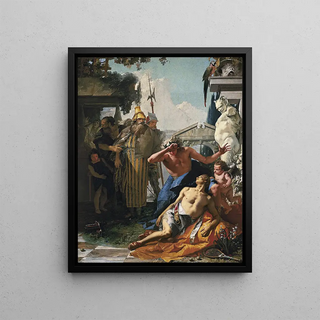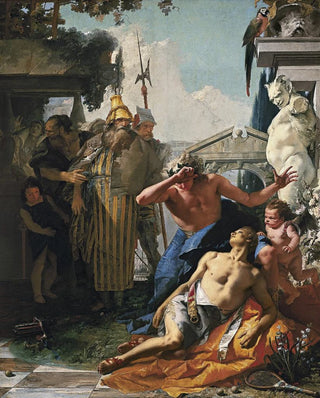Art print | The Death of Hyacinth - Giovanni Battista Tiepolo


View from behind

Frame (optional)
The canvas "The Death of Hyacinth" by Giovanni Battista Tiepolo is a work that transcends the simple frame of art to engage in a broader reflection on beauty, tragedy, and destiny. Immersing oneself in this masterpiece, the viewer is immediately transported into a universe where mythology and human emotion meet with striking intensity. The scene, imbued with melancholy, illustrates the tragic end of Hyacinth, a young man whose premature death evokes the pain of gods and mortals alike. Tiepolo, an undisputed master of the 18th century, manages to capture this fleeting moment with a virtuosity that leaves no one indifferent.
Style and uniqueness of the work
Tiepolo's style is characterized by a bold use of light and color, creating an atmosphere that is both dramatic and enchanting. In "The Death of Hyacinth," the painter skillfully plays with contrasts, highlighting vivid hues that emphasize the beauty of the young hero's body, while enveloping the scene in a tragic aura. The figures are rendered with fluid grace, each movement seeming to tell a story. The expressions of the characters, between sorrow and despair, are of rare emotional depth. Tiepolo succeeds in infusing vibrant life into his subjects, making this work a true ode to the ephemeral beauty of youth and the pain of loss.
The artist and his influence
Giovanni Battista Tiepolo, born in Venice, is one of the greatest masters of rococo. His career is marked by an incessant quest for perfection and innovation. Tiepolo does not merely reproduce classical mythological themes; he reinvents them, adapts them to his era, and enriches them with a new sensitivity. His influence is palpable in the art world, inspiring many artists, both contemporary and subsequent. The way he plays with light and space paved the way for generations of artists, making him an emblematic figure of the 18th century. His ability to transform

Matte finish

View from behind

Frame (optional)
The canvas "The Death of Hyacinth" by Giovanni Battista Tiepolo is a work that transcends the simple frame of art to engage in a broader reflection on beauty, tragedy, and destiny. Immersing oneself in this masterpiece, the viewer is immediately transported into a universe where mythology and human emotion meet with striking intensity. The scene, imbued with melancholy, illustrates the tragic end of Hyacinth, a young man whose premature death evokes the pain of gods and mortals alike. Tiepolo, an undisputed master of the 18th century, manages to capture this fleeting moment with a virtuosity that leaves no one indifferent.
Style and uniqueness of the work
Tiepolo's style is characterized by a bold use of light and color, creating an atmosphere that is both dramatic and enchanting. In "The Death of Hyacinth," the painter skillfully plays with contrasts, highlighting vivid hues that emphasize the beauty of the young hero's body, while enveloping the scene in a tragic aura. The figures are rendered with fluid grace, each movement seeming to tell a story. The expressions of the characters, between sorrow and despair, are of rare emotional depth. Tiepolo succeeds in infusing vibrant life into his subjects, making this work a true ode to the ephemeral beauty of youth and the pain of loss.
The artist and his influence
Giovanni Battista Tiepolo, born in Venice, is one of the greatest masters of rococo. His career is marked by an incessant quest for perfection and innovation. Tiepolo does not merely reproduce classical mythological themes; he reinvents them, adapts them to his era, and enriches them with a new sensitivity. His influence is palpable in the art world, inspiring many artists, both contemporary and subsequent. The way he plays with light and space paved the way for generations of artists, making him an emblematic figure of the 18th century. His ability to transform






